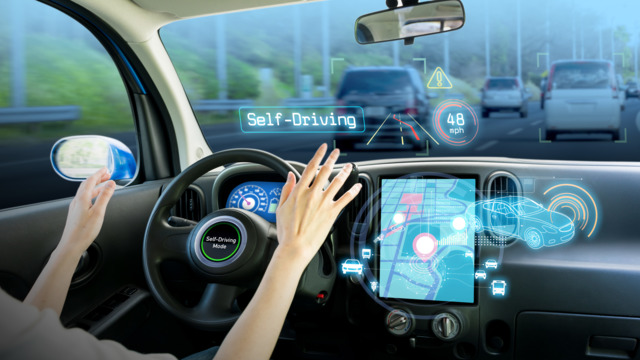A self-driving car is an automobile that can operate without a human driver at the wheel. It is also known as an autonomous or driverless vehicle, and it navigates itself with the help of hardware and software components.
Hardware components include things like cameras and other sensors, while the software comprises artificial intelligence programs that typically run off cloud servers belonging to the company operating such vehicles.
There are currently over 60 companies that have permits to test their self-driving cars on public roads in the United States. Most are fitted with unwieldy navigation systems comprising radar, Lidar, camera, infrared and other types of sensors to help them form an accurate “map” of the road ahead and the environment around them.
Tesla plans to offer full self-driving (FSD) capabilities for its electric vehicle (EV) fleet by the end of 2019, according to CEO Elon Musk, and the company has already introduced several advanced driver assistance system (ADAS) components with its Version 9 Tesla software. Tesla is reportedly in the process of testing its own AI chips in the Autopilot Hardware 3.0 that will go into future Tesla EVs.
There are several non-auto companies in the fray as well, since this is primarily an AI challenge rather than an automotive design task. These include Waymo (formerly of Google and now operating under the Alphabet umbrella), Apple and Uber (paused, but expected to resume soon in a downsized manner.)
Here’s a full list of companies that have been issued testing permits in the state of California by the state’s Department of Motor Vehicles as of January 28, 2019:
Volkswagen Group of America
Mercedes Benz
Waymo LLC
Delphi Automotive
Tesla Motors
Bosch
Nissan
GM Cruise LLC
BMW
Honda
Ford
Zoox, Inc.
Drive.ai, Inc.
Faraday & Future Inc.
Baidu USA LLC
Valeo North America, Inc.
NIO USA, Inc.
Telenav, Inc.
NVIDIA Corporation
AutoX Technologies Inc
Subaru
Udacity, Inc
Navya Inc.
Renovo.auto
PlusAi Inc
Nuro, Inc
CarOne LLC
Apple Inc.
Pony.AI
TuSimple
Jingchi Corp
SAIC Innovation Center, LLC
Almotive Inc
Aurora Innovation
Nullmax
Samsung Electronics
Continental Automotive Systems Inc
Voyage
CYNGN, Inc
Roadstar.Ai
Changan Automobile
Lyft, Inc.
Phantom AI
Qualcomm Technologies, Inc.
SF Motors Inc.
Toyota Research Institute
Apex.Al
Intel Corp
Ambarella Corporation
Gatik AI. Inc.
DiDi Research America LLC
TORC Robotics Inc
Boxbot Inc
EasyMile
Mando America Corporation
Xmotors.ai, Inc.
Imagry Inc.
Ridecell Inc.
AAA NCNU
ThorDrive Inc
Helm.AI Inc
Argo AI, LLC
As you can see, it’s a healthy mix of automakers, established tech names and startups. The landscape is fierce, and it’s a race to the finish line. But what exactly is the “finish line” for an autonomous vehicle? That depends on what level of autonomy we’re talking about.
The requirements of various levels of automation are clearly defined by the SAE. The explanation for these levels is as follows, courtesy Gigabit Magazine:
“Level 0: Fully manual vehicle
Level 0 accounts for the majority of vehicles on the road today, with all aspects of driving being fully human and manually controlled.
Level 1: One single automated aspect
Level 1 is the lowest level of automation. Hardly being described as driverless, the vehicle has a single aspect of automation that assists the driver with ADAS. Examples of this include steering, speed, or braking control, but never more than one of these.
Level 2: Automated steering and acceleration capabilities
SAE level 2 is where the vehicle is able to control both the steering and acceleration/ deceleration ADAS capabilities. Although this allows the vehicle to automate certain parts of the driving experience, the driver remains in complete control of the vehicle at all times. Examples of level 2 include helping vehicles to stay in lanes and self-parking features, with more than one ADAS aspect.
Level 3: Environment detection
Able to detect the environment around them, level 3 vehicles contain the lowest-tier system that is classified as an automated driving system as opposed to a manual system. With this more advanced technology, level 3 vehicles can make informed decisions for themselves such as overtaking slower moving vehicles. However, unlike the higher rated autonomous vehicles, human override is required when the machine is unable to execute the task at hand or the system fails.
Level 4: No human interaction required
The key difference between level 3 and level 4 automation is that level 4 vehicles are able to intervene themselves if things go wrong or there is a system failure. In this sense, these cars are left completely to their own devices without any human intervention in the vast majority of situations, although the option to manually override does remain in difficult or preferable circumstances.
Level 5: Human driving is completely eliminated
Similarly, level 5 vehicles do not require human attention. However, the key difference is the quality, with level 5 vehicles providing a much more responsive and refined service, comparable to that of adaptive and situational manual human driving.
Examples of where level 5 vehicles excel include off-road driving and other terrains that Level 4 vehicles may not necessarily be able to detect or intelligently comprehend. In other words, level 5 vehicles have a much more advanced environment detection system.
This is the only class of automated vehicles that
As you can clearly see, Level 4 and Level 5 are where true vehicular autonomy kick in. Nobody has yet reached that level, although Tesla and Waymo are far ahead of the rest and may have already mastered Level 3 automation in most terrains. This is the lowest level of autonomy required for a vehicle to qualify as a self-driving car.


